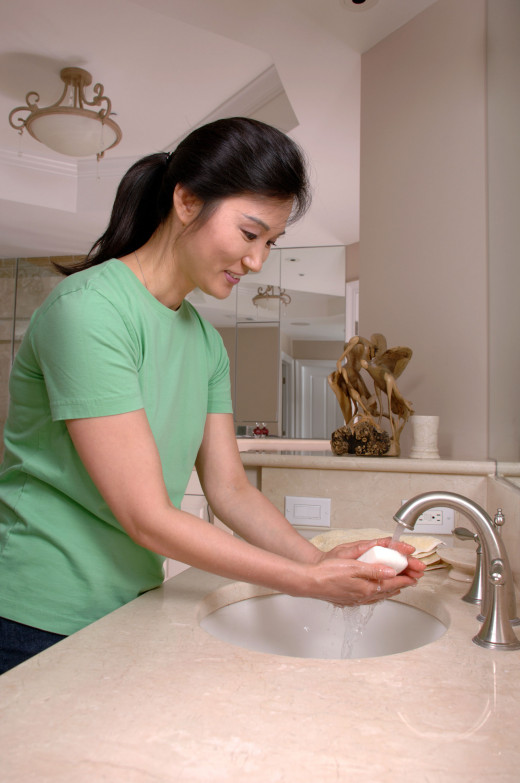How to Stay Safe with a Food Allergy
Always Read Food Labels

Read Food Labels
It seems like everyone knows someone who has food allergies nowadays. When I was growing up, nobody had food allergies!
Now, I have developed tree nut allergies and my son has severe peanut allergies. There are many things you can do to stay safe with a food allergy.
The Department of Health and Human Services has made it easy to find out which allergens are in each food product. Look at the nutrition facts on the label.
At the bottom of each ingredient list, you will see words in bold letters. These are the known allergens for that food product.
Food allergens are always listed at the bottom of the ingredient list in bold letters. No need to look through the whole ingredient list anymore!
The most common food allergies are: milk, eggs, peanuts, tree nuts, fish, shellfish, soy and wheat.
Woman washing hands

Wash Your Hands
Wash your hands often to make sure you do not have food allergens on your hands. Try to wash hands before and after you eat.
Wash with warm, soapy water for about twenty seconds. Get between the fingers and under the finger nails too.
Hand Washing Guidelines
- CDC Features - Wash Your Hands
Keeping hands clean is one of the best ways to prevent the spread of infection and illness.
- Raising a Child with Peanut Allergies: Peanut Allergies are on the Rise!
Peanut allergies are on the rise across the world. We are seeing more children with allergic reactions to peanuts than in any other time in history. My son has severe peanut allergies and goes to Kindergarten in public schools.
Let Others Know You Have Food Allergies
When eating with others, let them know that you or your child have food allergies.
If people are aware, they will be able to let you know if something has an allergen in it and watch for any symptoms. At potlucks, always ask what ingredients the preparer used in their recipe.
I went to a Mom's group cookie exchange a few years ago while my kids were toddlers. My son is severely allergic to peanuts, so I had to be wary of what was in everything. Because of food allergies with the kids, we were asked to bring the recipe for our cookies that we brought in.
It was nice because we could copy the recipe down if we really like it and we could see what was in each cookie. We were able to avoid the cookies with peanuts without questioning everyone about the ingredients in their cookies.
Food Allergy Recipes
- Food Allergy Recipes | Kids With Food Allergies
Parents of food allergic children have shared hundreds of their favorite recipes that are milk-free, egg-free, soy-free, nut-free, peanut-free, wheat-free, gluten-free, sesame-free, fish-free, and more. Our growing database allows you to search to me
Cook At Home More Often
It is always a gamble when you or your child with food allergies eat outside of the house. Allergens could be lurking in sauces, desserts or anything you eat.
Even prepackaged foods that you bring into the house can be risky although ingredient lists have made it easier to find food allergens in prepared food.
To cut some of your worries about allergic food reactions, make homemade meals! It is a little more work, but it is healthier, cheaper and you know exactly what is going into your food.
If a recipe calls for an ingredient you or your child are allergic to, then you can either omit the ingredient or toss the recipe in the garbage.
Either way, you know you that the allergen will not be in the food. No guesswork there!
How To Use An Epi-Pen
Carry An Epi-Pen
In case you come in contact with an allergen and have an allergic reaction, it is smart to have an Epi-Pen on hand at all times.
My allergist told me that Benadryl only works to get rid of the itching, but does not decrease swelling. Benadryl could help some of the symptoms of an allergic reaction, but a person could still suffocate from swelling, so it is always safe to carry an Epi-Pen.
Epi-Pen's normally come with a practice Epi-Pen that does not have the medicine or needle in it. Brush up on your Epi-Pen skills by bringing the practice one out every few months. Show your kids how to use it in case they need it while you are not around. It's very simple: take the lid off, firmly press the area where the needle would be against the outer thigh, hold for a few seconds, then pull needle straight out of the leg.
If you do need to use the Epi-Pen, always call 9-1-1 or go to your closest Emergency Room as soon as possible. Occasionally a second reaction occurs within a few hours of the first and they are sometimes worst than the first reaction.
Peanut Warning Sign

How To Stay Safe With A Food Allergy
- Homepage | Food Allergy Research & Education
FARE is the largest private funder of food allergy research advocating on behalf of the 32 million Americans living with potentially life-threatening food allergies.
This content is accurate and true to the best of the author’s knowledge and does not substitute for diagnosis, prognosis, treatment, prescription, and/or dietary advice from a licensed health professional. Drugs, supplements, and natural remedies may have dangerous side effects. If pregnant or nursing, consult with a qualified provider on an individual basis. Seek immediate help if you are experiencing a medical emergency.
© 2013 Melanie Casey








